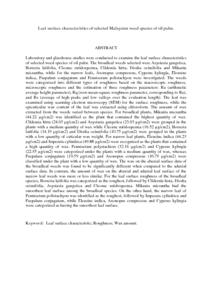Citation
Ngah, Noryati and Omar, Dzolkhifli and Juraimi, Abdul Shukor and Sajili, Mohammad Hailmi
(2011)
Leaf surface characteristics of selected Malaysian weed species of oil palm.
Journal of Agobiotechnology, 2 (1).
pp. 53-65.
ISSN 1985-5133
Abstract
Laboratory and glasshouse studies were conducted to examine the leaf surface characteristics of selected weed species of oil palm. The broadleaf weeds selected were Asystasia gangetica, Borreria latifolia, Cleome rutidosperma, Clidemia hirta, Diodia ocimifolia and Mikania micrantha, while for the narrow leafs, Axonopus compressus, Cyperus kylingia, Eleusine indica, Paspalum conjugatum and Pennisetum polistachyon were investigated. The weeds were categorized into different types of roughness based on the macroscopic roughness, microscopic roughness and the estimation of three roughness parameters: Ra (arithmetic average height parameter), Rq (root-mean-square roughness parameter, corresponding to Ra), and Rz (average of high peaks and low valleys over the evaluation length). The leaf was examined using scanning electron microscopy (SEM) for the surface roughness, while the epicuticular wax content of the leaf was extracted using chloroform. The amount of wax extracted from the weeds varied between species. For broadleaf plants, Mikania micrantha (44.22 µg/cm2) was identified as the plant that contained the highest quantity of wax. Clidemia hirta (24.03 µg/cm2) and Asystasia gangetica (23.03 µg/cm2) were grouped in the plants with a medium quantity of wax while Cleome rutidosperma (16.52 µg/cm2), Borreria latifolia (14.19 µg/cm2) and Diodia ocimifolia (10.75 µg/cm2) were grouped in the plants with a low quantity of cuticular wax weight. For narrow leaf plants, Eleusine indica (44.23 µg/cm2) and Imperata cylindrica (49.88 µg/cm2) were recognized as the plants that contained a high quantity of wax. Pennisetum polystachion (32.16 µg/cm2) and Cyperus kylingia (22.85 µg/cm2) were categorized under the plants with a medium quantity of wax, whereas Paspalum conjugatum (19.59 µg/cm2) and Axonopus compressus (16.78 µg/cm2) were classified under the plant with a low quantity of wax. The wax on the abaxial surface data of the broadleaf weeds was found to be significantly different when compared to the adaxial surface data. In contrast, the amount of wax on the abaxial and adaxial leaf surface of the narrow leaf weeds was more or less similar. For the leaf surface roughness of the broadleaf species, Borreria latifolia was categorized as the roughest, followed by Clidemia hirta, Diodia ocimifolia, Asystasia gangetica and Cleome rutidosperma. Mikania micrantha had the smoothest leaf surface among the broadleaf species. On the other hand, the narrow leaf of Pennisetum polistachyon was identified as the roughest, followed by Imperata cylindrica and Paspalum conjugatum, while Eleusine indica, Axonopus compressus and Cyperus kylingia were categorized as having the smoothest leaf surface.
Download File
![[img]](http://psasir.upm.edu.my/23796/1.hassmallThumbnailVersion/Leaf%20surface%20characteristics%20of%20selected%20Malaysian%20weed%20species%20of%20oil%20palm.pdf)  Preview |
|
PDF (Abstract)
Leaf surface characteristics of selected Malaysian weed species of oil palm.pdf
Download (85kB)
| Preview
|
|
Additional Metadata
Actions (login required)
 |
View Item |

